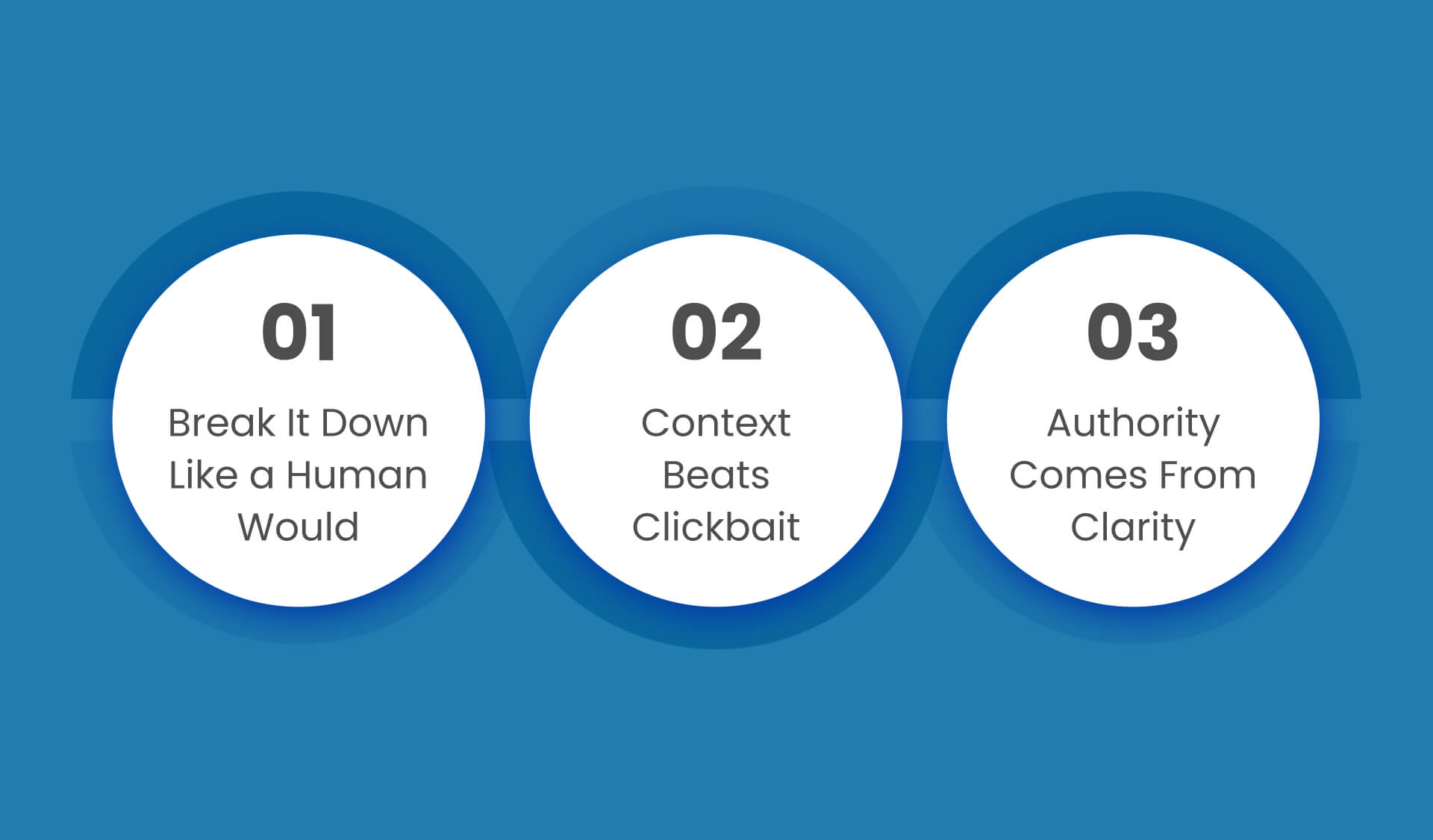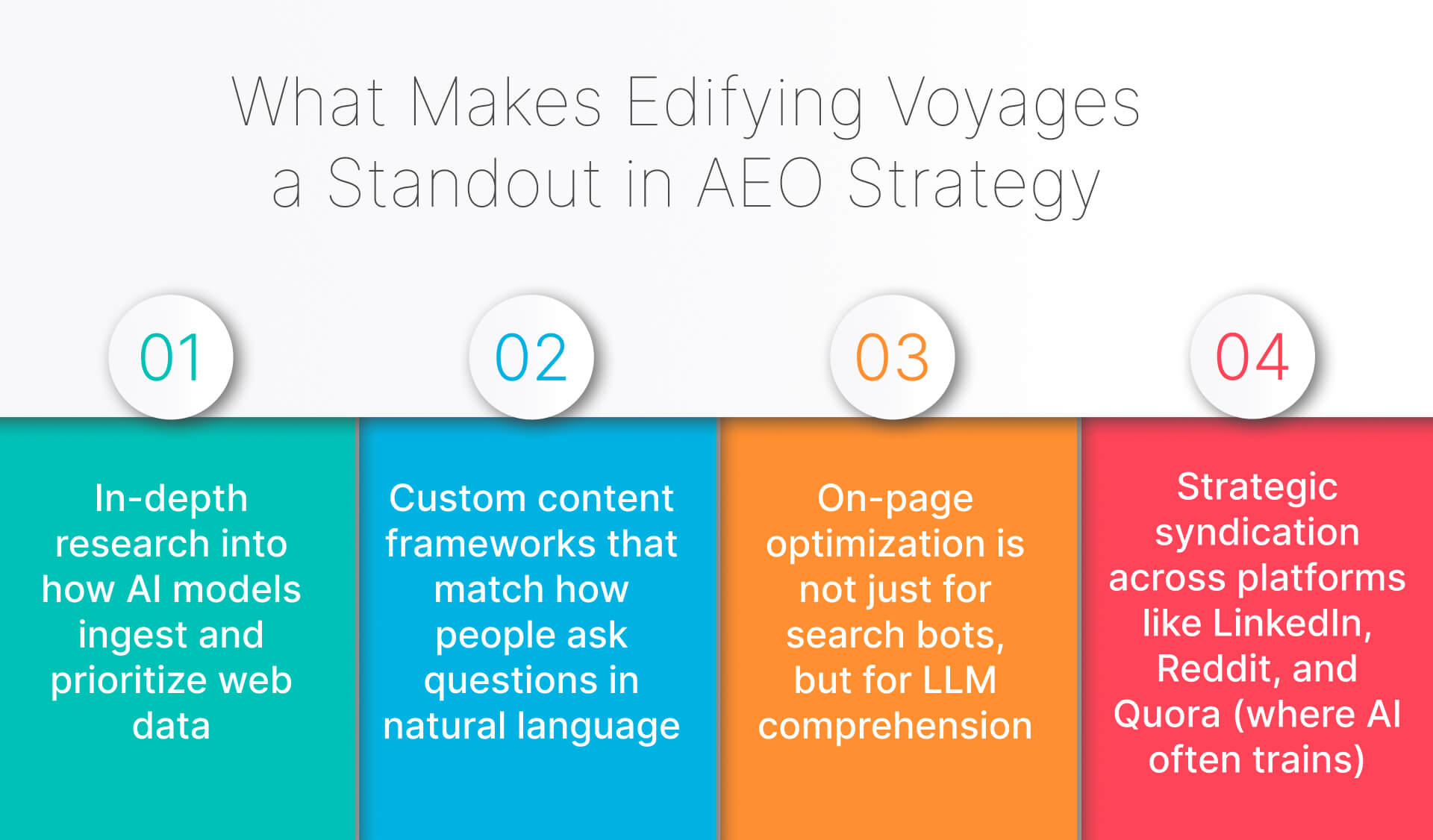Answer Engine Optimization Strategies for ChatGPT and LLMs

 10 min
10 min
There’s been a quiet shift in how people look for information online, and it’s no longer limited to Google searches and blog rankings. The rise of LLM and ChatGPT platforms is changing what it means to show up in front of potential customers. In this evolving space, businesses that once relied on traditional SEO are finding themselves outpaced by those leaning into something newer: answer engine optimization strategies for ChatGPT and LLMs.
This isn’t some passing fad. It’s a clear signal that the way visibility works online is changing and that brands must now be answerable to language models, not just searchable on Google.
The Shift from Ranking to Answering
Let’s face it, users no longer scroll past multiple links to find what they need. With AI assistants like ChatGPT, Gemini, and Perplexity giving instant answers, many don’t even click through to websites anymore. The game has changed. The real question now is: is the brand’s content part of the answer?
That’s where Answer Engine Optimization (AEO) steps in. Traditional SEO was about ranking on Google’s first page. AEO is about becoming the response, the data source that AI tools pull from to generate accurate, relevant answers in real time.
This shift matters more than it seems. AI tools aren’t just summarizing web pages; they’re choosing which sources to trust, which formats to surface, and how to phrase answers based on structured data and authority. So even if a business is technically “ranking,” it might still be invisible in an AI-driven interaction.
For businesses already investing in organic SEO services, AEO is the next evolution not a replacement, but a strategic extension. It’s about structuring content in a way that large language models can recognize, extract, and use in natural-language responses. In other words, it’s about future-proofing online visibility by making a brand part of the answer layer, not just the search index.
Whether it’s being quoted in a ChatGPT response, powering a voice assistant’s reply, or appearing in a Bing AI summary, AEO ensures brand content stays relevant in this new search landscape where answers are the new clicks.
Ready to Lead in the AEO Era?
Future search belongs to brands that answer, not just rank. Position your business as the trusted source for ChatGPT and LLMs before competitors dominate.
Start Your AEO Strategy Today
What Makes AEO for ChatGPT Different?
Think of it this way: traditional SEO was all about ranking higher on Google. AEO for ChatGPT is about making sure the content gets understood and used by language models.
That’s a big shift. LLMs like ChatGPT don’t follow the same rules as Google’s old search algorithm. They aren’t scanning for keyword density or counting backlinks. Instead, they look for clear explanations, structured answers, and content that actually makes sense in response to real questions.
So the old tricks cramming in keywords or writing just to please a search bot don’t help much here. What works now is writing that sounds natural, answers a question directly, and includes enough context for an AI to pull it into a response.
Good AEO content doesn’t feel like marketing copy. It reads more like a helpful, well-thought-out answer. It’s clean, to the point, and organized in a way that LLMs can understand. That’s the core of answer engine optimization strategies for ChatGPT and other tools making sure what’s written can be picked up, understood, and used by these new systems. By aligning with answer engine optimization services and adopting AEO strategy 2025 best practices, brands position themselves not just to rank but to lead the conversation.
Building Smarter Content for LLM and ChatGPT

To earn a place in AI-generated answers, content needs to be crafted with a new kind of precision. These are the foundational pillars of effective answer engine optimization strategies for ChatGPT and LLMs:
1. Break It Down Like a Human Would
Long paragraphs packed with jargon don’t help. Instead, think in bite-sized sections that mimic human conversation. AI models are more likely to pull from a well-structured Q&A format or a bulleted explanation than a dense 800-word wall of text.
2. Context Beats Clickbait
Clicky headlines may win attention on social feeds, but they confuse language models. Straightforward headlines like “What Is Cloud Migration?” or “How Does AEO for ChatGPT Work?” give the AI a clearer signal of what’s being said.
3. Authority Comes From Clarity
There’s a difference between being an expert and sounding like one. The latter often loses the room. Great answer engine optimization strategies for ChatGPT and LLMs prioritize helpfulness over heavy-handedness. Facts over fluff. Structure over style.
Want to Be the Answer, Not the Option?
The future of discoverability is about owning the answer layer. Let’s align your content to lead in AI-powered results.
Claim My Consultation
AEO for ChatGPT Is Already Changing How Brands Are Found
Businesses experimenting with AEO strategies for ChatGPT are starting to notice a shift. Their blog posts, service pages, and even FAQs are being referenced in ChatGPT replies, showing up in Bing AI snapshots, and mentioned across Gemini's assistant results. This kind of exposure doesn’t look like traditional search rankings; it’s more subtle but equally powerful. It helps the brand get seen where users are asking real questions and expecting straight answers, especially when aligned with local SEO company strategies that connect content to specific user intent and locations.
That kind of placement often builds quiet trust. When the same name keeps showing up in different responses, people start paying attention. It creates familiarity. And over time, that turns into better click-through rates, more direct engagement, and stronger loyalty.
But getting to that level doesn’t happen with one or two well-optimized articles. What’s working now is consistency across the board. Brands doing well in this space tend to have clusters of content that are tightly connected. One topic leads to another. Important themes repeat naturally across blogs, guides, and help pages. This kind of structure gives ChatGPT and other LLM tools more context to work with. It’s easier for them to figure out what the brand really knows and where it fits in the bigger picture.
The goal isn’t just to chase AI placement, it’s to build a content environment that’s clear, useful, and tied together. That’s what helps models return the brand’s insights more often, and in more meaningful places.
What Makes Edifying Voyages a Standout in AEO Strategy

Edifying Voyages has been ahead of the curve when it comes to answering engine optimization strategies for ChatGPT and LLMs. Long before AEO became a buzzword, the team was already helping businesses create content that worked not just for humans but for algorithms trained to think like them.
Here’s how the approach stands apart:
- In-depth research into how AI models ingest and prioritize web data
- Custom content frameworks that match how people ask questions in natural language
- On-page optimization is not just for search bots, but for LLM comprehension
- Strategic syndication across platforms like LinkedIn, Reddit, and Quora (where AI often trains)
The goal isn’t just to “show up” in answers. It’s to become the source the models rely on.
Ready to Outpace Competitors in AI Search?
Early adopters in Answer Engine Optimization are building trust fast. Get your brand cited, quoted, and recommended by AI platforms.
Talk to an AEO Expert
AI Implementation That Goes Beyond Just Content
The strength of Edifying Voyages isn’t just in writing AI-friendly copy, it’s in deploying AI in a way that directly supports business growth.
Whether it’s building prompt-optimized content hubs or integrating AEO for ChatGPT directly into client workflows, Edifying takes a strategic approach that aligns AI capabilities with real-world outcomes.
Some of the recent wins include:
- Creating brand-specific knowledge repositories used for internal ChatGPT training
- Developing smart customer service systems powered by natural language AI
- Training internal teams to generate AEO-optimized content across departments
The result? Businesses get more than just content they get a long-term edge in how they’re understood, found, and trusted by both people and machines.
Practical Tips to Get Started with Answer Engine Optimization

For those exploring the transition from SEO to AEO, here are some foundational steps:
- Conduct a content audit focused on structure, not just keywords
- Rewrite existing blog posts to include conversational Q&A sections
- Build out pillar pages with internal links that reinforce context
- Publish explainer-style content with clear answers to long-tail queries
- Monitor traffic not just through Google Search Console, but through Bing AI and Perplexity citations
The more content aligns with natural inquiry patterns, the better it performs in LLM and ChatGPT environments.
Ready to Build AI-Optimized Content Clusters?
Clusters win in the new search economy. Let’s create a connected content system that AI ranks and reuses in every relevant answer.
Get My Content Blueprint
Why Now Is the Time for Answer Engine Optimization Strategies for ChatGPT and LLMs
Right now, there’s a rare opportunity. Most businesses are still thinking in terms of traditional search rankings, unaware that the way people discover information is already shifting. Tools like ChatGPT, Claude, and Gemini are becoming go-to sources for quick, reliable answers, and that means the content they draw from is now more influential than ever.
This is where Answer Engine Optimization (AEO) comes in. It’s not just another trend; it’s a fundamental change in how content is surfaced, interpreted, and delivered. Instead of aiming for top placement on a results page, AEO focuses on making content usable in AI-generated answers the kind that people trust, read, and act on without ever clicking through to a website.
And this shift is accelerating. AI-powered assistants are being integrated into everyday tools, such as browsers, devices, customer service platforms, and search engines. In that ecosystem, only content that’s clear, structured, and contextually rich will be surfaced. The brands showing up there won’t get there by accident they’ll get there through smart strategy.
That’s why now is the time to act. The early advantage is real. Once competitors begin optimizing their content for these new systems, standing out becomes harder. Those who start early will set the standard. They’ll shape how their services, expertise, and insights are represented across these AI tools, not just wait to see how others define it.
Answer engine optimization strategies for ChatGPT and LLMs aren’t just about visibility; they’re about positioning. They ensure that a brand’s voice is included in the conversation, not left behind while others take the spotlight.
For brands that are serious about leading this next wave of digital discovery, this is the moment to build. And with Edifying Voyages as a partner, the strategy doesn’t just stay theoretical; it becomes measurable, scalable, and tailored for real impact.
Conclusion
The landscape of search has changed. It’s no longer about visibility alone; it’s about authority, trust, and being the definitive answer when it matters most. That’s exactly what answer engine optimization services are designed to achieve.
By embracing answer engine optimization AEO strategy 2025 best practices, brands take a bold step into the future of search one that’s led by AI, powered by structure, and driven by clarity. Visibility in 2025 depends on being the content that AI platforms trust and surface first, not just being somewhere on page one.
Partnering with a forward-thinking offshore SEO agency like Edifying Voyages ensures that every piece of content serves a strategic purpose not just to rank, but to answer. With the right systems in place and support from experts who understand both AEO and traditional SEO fundamentals, brands can lead the next phase of digital discoverability with confidence.
In a world where answers are currency, businesses that invest in smart, ongoing answer engine optimization services won’t just keep up they’ll stand out.
FAQs
Answer Engine Optimization (AEO) focuses on making content usable by AI tools, not just search engines. While SEO chases rankings, AEO structures clear, contextual answers that language models like ChatGPT can directly surface to users.
AEO aligns content with how AI understands and retrieves information. By providing structured, conversational answers, brands increase their chances of being selected as trusted sources in AI-generated responses.
Yes, but context matters more. Instead of stuffing keywords, AEO weaves them naturally into precise, well-structured answers, allowing AI to identify relevance without sacrificing clarity or readability.
Absolutely. By reworking existing content into Q&A formats, adding structured headings, and clarifying context, brands can make their current assets AI-ready without starting from scratch.
LLMs prioritize clarity, trustworthiness, and contextual depth. Well-structured content with accurate information and natural phrasing has a higher chance of being surfaced over vague or overly promotional text.
Early adopters gain a competitive edge while others focus only on traditional SEO. With AI-driven search adoption accelerating, being “answer-ready” now sets the stage for long-term discoverability.




